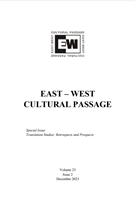On the Efficiency and Efficacy of Machine-Assisted Literary Translation: A Case Study for English/Romanian and Romanian/English Machine-Assisted Translation
On the Efficiency and Efficacy of Machine-Assisted Literary Translation: A Case Study for English/Romanian and Romanian/English Machine-Assisted Translation
Author(s): Emilian TîrbanSubject(s): Social Informatics, Sociology of Culture, Translation Studies, Theory of Literature, ICT Information and Communications Technologies, Sociology of Literature
Published by: Editura Universitatii LUCIAN BLAGA din Sibiu
Keywords: techno-determinism; machine-assisted translation; gist translation; literary translation; digital age; neural machinetranslation; artificial intelligence;
Summary/Abstract: “If you translate long into the machine, the machine translates back into you,” is one of the issues the present article strives to establish and explore qualitatively. I intend to examine the effectiveness and efficiency of machine-assisted translations of significant literary works from a hermeneutical perspective. Essentially, I analyse the output of automated translation platforms such as Google Translate and compare them to human translation. This investigation is valuable in determining whether translators should exercise caution when utilizing translation platforms for culturally rich literary works. Additionally, the article scrutinizes the localisation, cultural, and grammatical coherence of Homer’s The Iliad translated from English to Romanian using the Google Translate platform. The human translations used are rendered into English and Romanian from Greek. As Homer’s Greek remains incomprehensible to the translation platform, we employ a secondary translation technique for a tertiary machine-assisted output. Nonetheless, this approach highlights the serious pitfalls of using translation platforms haphazardly in translation work. This analysis will show how awareness of the machine’s imperfect translation capabilities may, in turn, enhance the human translator’s awareness of what works while translating with the help of a translation application.
Journal: East-West Cultural Passage
- Issue Year: 23/2023
- Issue No: 2
- Page Range: 59-79
- Page Count: 21
- Language: English
- Content File-PDF

